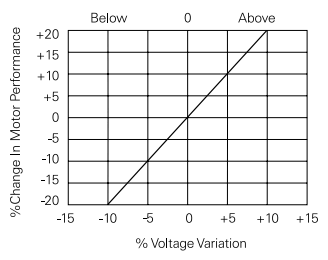Several factors can affect the performance of an AC motor. These must be considered when applying a motor.
Voltage Variation
As previously discussed, AC motors have a rated voltage and frequency. Some motors have connections for more that one rated voltage. The following table on Picture 1 shows the most common voltage ratings for NEMA motors.
Picture 1: Standardized voltages and frequencies
A small variation in supply voltage can have a dramatic affect on motor performance. In the following chart shown on Picture 2, for example, when voltage is 10% below the rated voltage of the motor, the motor has 20% less starting torque. This reduced voltage may prevent the motor from getting its load started or keeping it running at rated speed. A 10% increase in supply voltage, on the other hand, increases the starting torque by 20%. This increased torque may cause damage during startup. A conveyor, for example, may lurch forward at startup. A voltage variation also causes similar changes in the motor’s starting and full-load currents and temperature rise.
Picture 2: Change in motor performance with voltage variation
Frequency
A variation in the frequency at which the motor operates causes changes primarily in speed and torque characteristics. A 5% increase in frequency, for example, causes a 5% increase in full-load speed and a 10% decrease in torque (Picture 3).
Picture 3: Frequency variation effects
Altitude
Standard motors are designed to operate below 3300 feet. Air is thinner, and heat is not dissipated as quickly above 3300 feet. Most motors must be derated for altitudes above 3300 feet. The following chart on Picture 4 shows typical horsepower derating factors, but the derating factor should be checked for each motor. A 50 HP motor operated at 6000 feet, for example, would be derated to 47 HP, providing the 40°C ambient rating is still required.
Picture 4: Altitude derating factor
Ambient Temperature
The ambient temperature may also have to be considered. The ambient temperature requirement may be reduced from 40°C to 30°C at 6600 feet on many motors. However, a motor with a higher insulation class may not require derating in these conditions (Picture 5).
Picture 5: Ambient temperature reduces with altitude





No comments:
Post a Comment